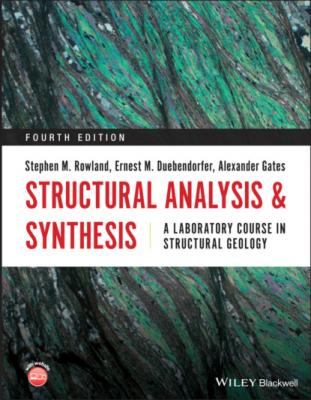ТОП просматриваемых книг сайта:
Structural Analysis and Synthesis. Stephen M. Rowland
Читать онлайн.Название Structural Analysis and Synthesis
Год выпуска 0
isbn 9781119535485
Автор произведения Stephen M. Rowland
Жанр География
Издательство John Wiley & Sons Limited
2 On the superimposed structure‐contour map and topographic map (Figure 2.13c), every point where a structure contour crosses a topographic contour of equal elevation is a surface outcrop. The outcrop map is made by marking each point where topographic and structure contours of the same elevation cross. Connect the points of intersection to display the outcrop pattern on the topographic map (Figure 2.13d).
This same technique can be used to locate a second surface that is parallel to the first. If the contact shown in Figure 2.13d is the top of a bed, we can determine the outcrop pattern of the bottom of the bed as well. If a single outcrop point on the topographic map is known, then the outcrop pattern can be found using the structure‐contour map already constructed for the bed's upper surface as follows:
Figure 2.13 Determination of outcrop pattern using structure contours. (a) Three structure contours on a base map (from Figure 2.10c). (b) Structure‐contour map. (c) Structure‐contour map superimposed on a topographic map. (d) Outcrop pattern of a plane on a topographic map.
Figure 2.14 (a) Structure‐contour map from Figure 2.13 shifted such that the 200‐ft structure contour lies on point Z. Point Z is a point where the bottom of a layer is exposed. The top of this same layer is exposed at points A, B, and C from Figure 2.11a. (b) Outcrop pattern of this layer, which dips 30° to the southeast.
1 Position the structure‐contour map beneath the topographic map such that the bottom surface outcrop point (or points) lies (lie) at the proper elevation on the structure‐contour map. With the structure contours parallel to their former position, proceed as before. In Figure 2.14a, point Z, at an elevation of 200 ft, is an outcrop of the bottom of the bed. The structure‐contour map has been moved so that the 200‐ft structure contour passes through point Z, and the predicted outcrop points have been located as before.
2 Once the upper and lower contacts are drawn on the topographic map, the outcrop pattern of the bed can be shaded or colored (Figure 2.14b).
1 Assuming that the water table is planar, construct structure contours for the water table.
2 Draw the cross section X to X’, showing the topography and the water table.
3 Shade the area where the properties would be impacted by the pollutant plume.
Gently Bent Layers
The technique of gently bent layers for locating the intersection of a geologic surface with the surface of the earth may be roughly used if the surface has a simple change in dip and a structure‐contour map can be constructed. In Figure 2.15a, three attitudes of a marker bed are mapped and all are different. Assuming a constant slope and a gradual change in dip between outcrop points, a structure‐contour map may be constructed as follows:
1 Arithmetically interpolate between the known elevation points to locate the necessary elevation points on the surface (Figure 2.15b).
2 Draw smooth parallel structure contours parallel to the strikes at the outcrop points (Figure 2.15c).
3 Superimpose the structure contour map and the topographic map and mark the points where contours of equal elevation intersect (Figure 2.15d).
4 Connect these intersection points to produce the outcrop map (Figure 2.15e).
Figure P2.5 is a topographic map. Points A, B, and C are outcrop points of the upper surface of a planar coal seam. Point Z is an outcrop point of the base of the coal seam.
1 Determine the attitude of the coal seam.
2 Draw the outcrop pattern of the coal seam.
3 Determine the thickness of the coal seam. Attach any drawings and computations you use.

